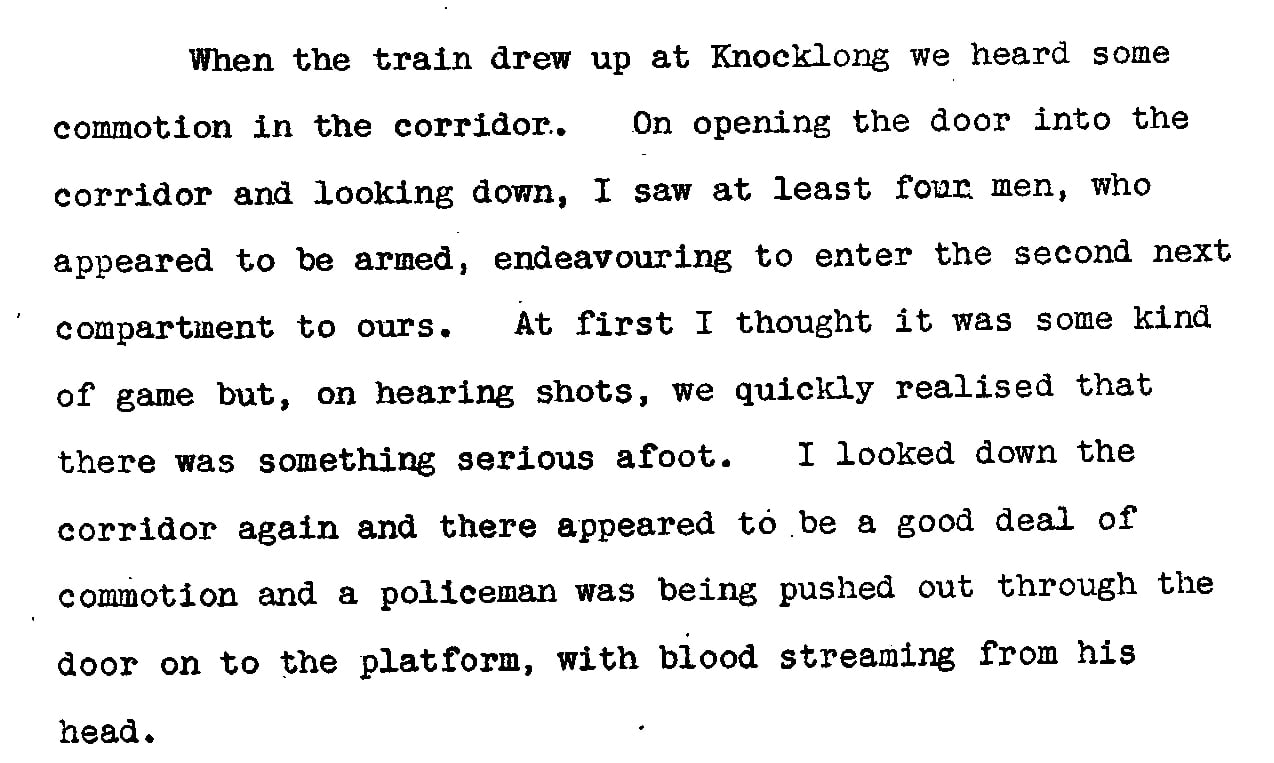Two RIC men killed in ambush in Knocklong
Archbishop denounces crime against ‘God and Ireland’
Limerick, 16 May 1919 - Two RIC men were killed on 13 May when a train carrying a prisoner, Seán Hogan, was attacked by a party of armed men as it passed through Knocklong, Co. Limerick.
Hogan, a farmer’s son from Greenane, Co. Tipperary, who had been wanted by the police for some time in connection with the Soloheadbeg assault, was freed by the attackers.
The two policemen killed in the incident have been named by the authorities. Constable Michael Enright, 33, unmarried and from Ballyneety, Co. Limerick, was shot in the heart. The other victim was Sergeant Peter Wallace, 44, was a married man and a native of Co. Roscommon.
Eyewitness statement
Two other policemen were also escorting the prisoner. One,
Constable J. O’Reilly, an Antrim man, gave an eyewitness
account to the Cork Examiner newspaper. He recalled how
about five men rushed the door of their train compartment when the
train stopped at Knocklong.
Each had a revolver and they let out a shout of ‘Hands up’, but in the hubbub shots were fired and one of the attackers was heard by Constable O’Reilly to shout out: ‘Kill them.’
Constable O’Reilly told of seeing Sergeant Wallace being beaten on the head by two of the raiding party with butts of revolvers. O’Reilly was also struck, with the butt of his own carbine. He then fell to floor of the carriage and received further blows until he was knocked unconscious.
When he came to, the prisoner, Sean Hogan, was gone and the only person he could see was Constable Enright, although he wasn’t sure if he was dead or alive. Then, struggling to make his way from the carriage, he saw men attacking Sergeant Wallace on the platform.
A number of men subsequently took flight along the platform and he fired in their direction, but didn’t follow. He also saw men running along the railway track in the direction of Cork and though he fired at them and followed along the tracks for a distance, the two men split in different directions, into the fields.
Excerpt from the Bureau of Military History witness statment of Dr Joseph Kearney who was also on the train carrying Seán Hogan that was attacked at Knocklong Station. Click on image to view document in full (Image: Bureau of Military History, BMH.WS0704)
Reaction
Dr John Harty, the Archbishop of Cashel, has denounced incident as
a crime against God and a crime against Ireland.
The Archbishop, who made his remarks while on a visit to Gallbally, near Knocklong, also appealed to the people to stay true to their Catholic spirit and urged the young men in particular not to ‘stain the fair fame of their native land by deeds of bloodshed’.
It was not, he said, an excuse to simply point to the outrages committed by the British government against Ireland, as two wrongs did not make a right.
King George echoed Dr Harty’s outrage. In a message to Lord French, the Lord Lieutenant, the King has expressed shock at the ‘dastardly attack upon members of the splendid Royal Irish Constabulary’.
What the papers are saying
The Irish Times has described the Knocklong ambush as a
‘brutal and audacious’ act by a ‘band of
ruffians’. The newspaper hopes, however, that out of the
outrage the world will have its eyes opened to the
‘desperate and lawless state of Southern Ireland’.
It has also paid tribute to the work of the RIC. ‘The work of the Irish policeman is now, more than ever, the most difficult, the most dangerous, and the most thankless work in the whole service of the Crown. It is performed, now as ever, with a calm outrage and steadfast loyalty which are beyond all praise.’
Furthermore, the Irish Times has urged the government to fulfil its ‘one paramount duty to Ireland. It must restore the sanctions of the law; it must protect the King’s servants; it must make life safe and tolerable for all decent Irish men; it must dissipate the reign of terror which allows murder to be committed with impunity by armed gangs in the full light of day.’
[Editor's note: This is an article from Century Ireland, a fortnightly online newspaper, written from the perspective of a journalist 100 years ago, based on news reports of the time.]






















